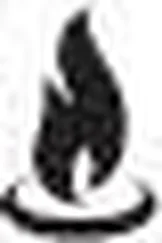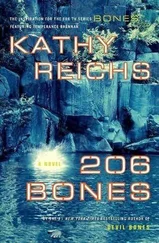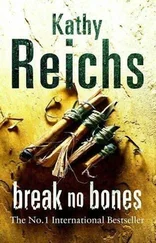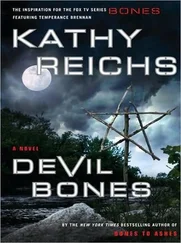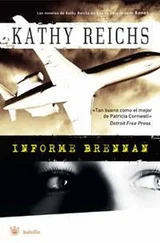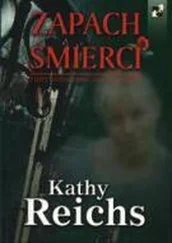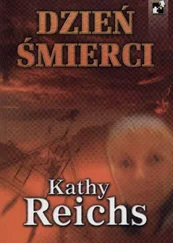Kathy Reichs - Bare Bones
Здесь есть возможность читать онлайн «Kathy Reichs - Bare Bones» весь текст электронной книги совершенно бесплатно (целиком полную версию без сокращений). В некоторых случаях можно слушать аудио, скачать через торрент в формате fb2 и присутствует краткое содержание. Жанр: Старинная литература, на английском языке. Описание произведения, (предисловие) а так же отзывы посетителей доступны на портале библиотеки ЛибКат.
- Название:Bare Bones
- Автор:
- Жанр:
- Год:неизвестен
- ISBN:нет данных
- Рейтинг книги:4 / 5. Голосов: 1
-
Избранное:Добавить в избранное
- Отзывы:
-
Ваша оценка:
- 80
- 1
- 2
- 3
- 4
- 5
Bare Bones: краткое содержание, описание и аннотация
Предлагаем к чтению аннотацию, описание, краткое содержание или предисловие (зависит от того, что написал сам автор книги «Bare Bones»). Если вы не нашли необходимую информацию о книге — напишите в комментариях, мы постараемся отыскать её.
Bare Bones — читать онлайн бесплатно полную книгу (весь текст) целиком
Ниже представлен текст книги, разбитый по страницам. Система сохранения места последней прочитанной страницы, позволяет с удобством читать онлайн бесплатно книгу «Bare Bones», без необходимости каждый раз заново искать на чём Вы остановились. Поставьте закладку, и сможете в любой момент перейти на страницу, на которой закончили чтение.
Интервал:
Закладка:
The place looked as though someone had hired an ornithologist, then consulted a “Birds Us” catalog to equip the office with what were thought to be exemplary furnishings.
Actually, Rachel had done it herself. One of the foremost ornithologists in the country, Rachel Mendelson was passionate about her science. She lived, breathed, slept, dressed, and probably dreamed birds. Her home, like her office, was resplendent with feathered subjects, both living and inanimate. On each visit I expected a shrike or a spoon-bill to swoop in, settle in the recliner, and begin hogging the remote.
A window filled the upper half of the wall opposite the door. The blinds were half open, allowing a partial view of Van Landingham Glen. The rhododendron forest shimmered like a mirage in the mid-morning heat.
A desk sat squarely in front of the window. Two chairs faced it, standard-issue metal with upholstered seats. One held a stuffed puffin, the other a pelican.
The desk chair looked like something designed for astronauts with orthopedic complaints. It held Dr. Rachel Mendelson.
Barely.
She looked up when we entered, but didn’t rise.
“Good morning,” Rachel said, then sneezed twice. Her head double-dipped, and her topknot bobbed.
“Sorry we’re late,” I said when Rachel had recovered. “Traffic was terrible on Harris Boulevard.”
“That’s why I’m always on the road by first light.” Even her voice was birdlike, with an odd, chirpy quality to it.
Rachel pulled a tissue from a painted owl holder, and blew her nose loudly.
“Sorry. Allergies.”
She wadded the tissue, tossed it into something below the desk, and lumbered to her feet.
It wasn’t much of a lumber, since Rachel stood only five feet tall. But what the woman lacked in height she made up for in breadth.
And color. Today Rachel was wearing lime green and turquoise. Lots of it.
For as long as I’d known Rachel, she had struggled with her weight. Diet after diet had enthused then failed her. Five years back she’d tried a regimen of veggies and canned shakes and dropped to 180, her all-time postpubescent best.
But try as she might, nothing lasted. By some bizarre chromosomal trick, Rachel’s set point seemed stuck at 227.
As though to compensate, her double helices granted Rachel thick, auburn hair, and the most beautiful skin I have ever seen.
And a heart big enough to accommodate a Radio City Music Hall Rockettes finale.
“Bonjour, Monsieur Ryan.” Rachel extended a chubby hand.
Ryan kissed the back of her fingers.
“Bonjour, madame. Parlez-vous français?”
“ Un petit peu. My grandparents were québecois .”
“Excellent.”
Rachel’s eyes swung to me. Her brows rose and her lips rounded into a tiny O.
“Just say ‘down, boy,’ ” I said.
Ryan released her hand.
“Down, boy.” Rachel made a palms-down movement with both hands. “And girl.”
We all sat.
Ryan pointed to a metal sculpture atop a pile of exam books.
“Nice duck.”
“It’s a grebe,” Rachel corrected.
“You can put this visit on his bill.” Ryan.
“You know, I’ve never heard that one before.” Rachel could be as deadpan as Ryan. “Now. What’s this about a dead bird?”
Keeping details to a minimum, I explained the situation.
“I’m not top-drawer with bones, but I’m crackerjack with feathers. Let’s go into my lab.”
If Rachel’s office held a few dozen genera of birds, her lab was home to the entire Linnaean lineup. Kestrels. Shrikes. Moorhens. Condors. Hummingbirds. Penguins. There was even a stuffed kiwi in a glass-fronted cabinet at the far end.
Rachel led us to a black-topped worktable and I spread the bones on it. Raising half-moon glasses from her bosom to her nose, she poked through the assemblage.
“Looks like Psittacidae.”
“I thought so, too,” said Ryan.
Rachel did not look up.
“Parrot family. Cockatoos, macaws, loris, lovebirds, parakeets.”
“I had a pip of a parakeet when I was a kid,” said Ryan.
“Did you?” said Rachel.
“Named him Pip.”
Rachel glanced at me, and the chains on her half-moons swung in unison.
I pointed to my temple and shook my head.
Returning her attention to the table, Rachel selected the breastbone and gave it an appraising look.
“Probably a macaw of some sort. Too bad we don’t have the skull.”
A flashback. Larabee speaking of the headless passenger.
“Too small for a hyacinth’s. Too big for a red-shouldered.”
Rachel turned the sternum over and over in her hands, than laid it on the table.
“Let’s see the feathers.”
I unzipped the baggie and shook out the contents. Rachel’s eyes dropped back to the table.
If a woman can lock up, Rachel did it. For several seconds not a molecule of her being moved. Then, reverently, she reached out and picked up one feather.
“Oh, my.”
“What?”
Rachel gaped at me like I’d just pulled a nickel from her ear.
“Where did you get these?”
I repeated my explanation about the farmhouse basement.
“How long were they down there?”
“I don’t know.”
Rachel carried the feather to a work counter, pulled two strands from it, placed them on a glass slide, dropped liquid onto them, poked and repositioned them with the tip of a needle, blotted, and added a cover slip. Then she settled her ample buttocks on a round, backless stool, fiddled and adjusted, and peered through a microscope.
Seconds passed. A minute. Two.
“Oh, my.”
Rachel rose, waddled to a bank of long, wooden drawers, and withdrew a flat, rectangular box. Returning to the scope she removed the slide she had just prepared, selected one from the box, and viewed the latter.
Puzzled, Ryan and I exchanged glances.
Rachel followed the first reference slide with another from the box, then went back to the slide made from Rinaldi’s feather.
“I wish I had a comparison scope,” she said, exchanging Rinaldi’s feather for a third reference slide. “But I don’t.”
When Rachel finally looked up her face was flushed and her eyes were wide with excitement.
18
“C YANOPSITTA SPIXII .” HUSHED, LIKE A ZEALOT SPEAKING THEname of her god.
“That’s some kind of parrot?” Ryan asked.
“Not just any parrot.” Rachel pressed both palms to her chest. “The world’s rarest parrot. Probably the world’s rarest bird.”
The crossed hands rose and fell with the lime-turquoise bosom.
“Oh, my.”
“Would you like water?” I asked.
Rachel fluttered agitated fingers.
“It’s a macaw, actually.” Slipping off her half-moons, she let them drop to the end of their chain.
“A macaw is a type of parrot?”
“Yes.” She lifted the feather from beside the scope and stroked it lovingly. “This is from the tail of a Spix’s macaw.”
“Do you have a stuffed specimen?” Ryan asked.
“Certainly not.” She slid from her stool. “Thanks to habitat destruction and the cage-bird trade, there aren’t any more. I’m lucky to have the reference slides for the feathers.”
“What is it you look at?” I asked.
“Oh, my. Well, let me see.” She thought a moment, going through her own KISS abridgment. “Feathers have shafts out of which grow barbs. The barbs have mini-barbs, called barbules, connected by structures called nodes. In addition to the overall morphology and color of the feather, I look at the shape, size, pigmentation, density, and distribution of those nodes.”
Rachel went to one of the shelves above the drawers and returned with a large brown volume. After checking the index, she opened and laid the book flat.
Читать дальшеИнтервал:
Закладка:
Похожие книги на «Bare Bones»
Представляем Вашему вниманию похожие книги на «Bare Bones» списком для выбора. Мы отобрали схожую по названию и смыслу литературу в надежде предоставить читателям больше вариантов отыскать новые, интересные, ещё непрочитанные произведения.
Обсуждение, отзывы о книге «Bare Bones» и просто собственные мнения читателей. Оставьте ваши комментарии, напишите, что Вы думаете о произведении, его смысле или главных героях. Укажите что конкретно понравилось, а что нет, и почему Вы так считаете.



